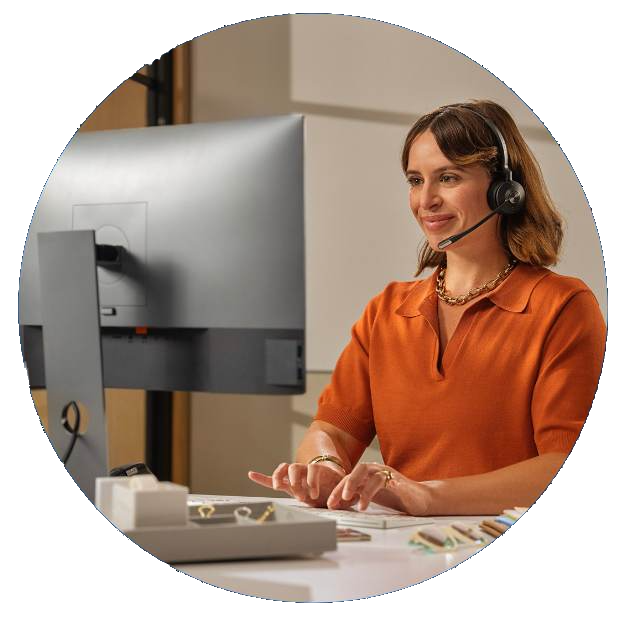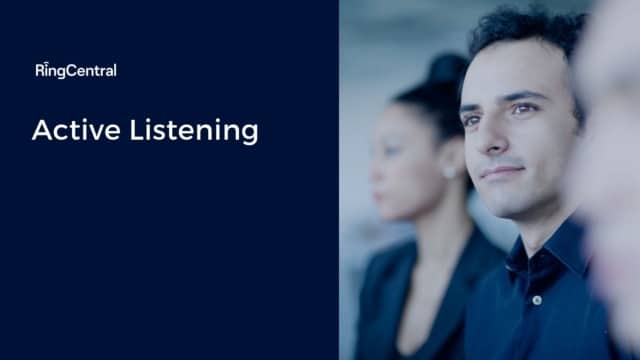Whether in our personal or professional lives, we all want to know we’re being listened to. In professional environments, showing our customers, clients, or colleagues that we’re actively listening to them is a vital part of our interpersonal skills.
Some people are natural listeners, but in professional environments, active listening isn’t always simple, especially when we must listen to people over the phone or on a video call.
This guide will tell you everything you need to know about active listening, why it’s important, and how to improve your active listening skills.
What is active listening?
Active listening is the practice of showing someone you’re listening through verbal and non-verbal cues.
Whilst an element of active listening is simply listening closely. And it also involves conveying this to the person you are listening to and ensuring you remain engaged with what they are saying.
What is the main purpose of active listening?
Active listening has two main purposes, one that impacts you and one that impacts the person you’re listening to:
- The first purpose of active listening is to structure how you listen and respond to others to ensure you understand, interpret, evaluate, and respond to what you hear helpfully.
- The second purpose of active listening is to show the person you’re listening to that you are doing all these things, which builds trust and appreciation between you and the speaker.
Active listening benefits both people engaged in a conversation and ensures that the conversation is meaningful and productive.
What are the benefits of active listening?
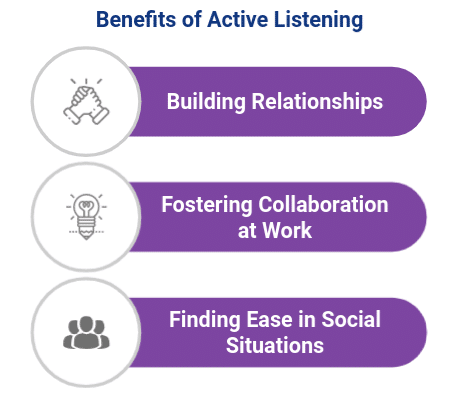
-
Building relationships
In a professional environment, effective communication is key to building trust in your relationships. Whether you’re listening to customers, clients, or colleagues, anyone talking to you wants to know that what they’re saying is being listened to, understood, and acknowledged.
Active listening helps you do this, making it an important part of your communication skills at work. It shows whoever you’re listening to that you value their time and what they have to say, whilst also ensuring that you give your full attention to them.
-
Fostering collaboration at work
Business collaboration is one of the key routes to fostering a culture of communication, innovation, and problem-solving at work. If you want your team to collaborate more effectively, active listening is essential.
If you and someone else at work are collaborating on a project, both voices need to be heard equally. Active listening not only shows every member of a collaboration that their voice is valued, but it also helps everyone listen to each other with more care.
-
Finding ease in social situations
Whilst exciting collaborations and persuasive conversations at work are great, not every discussion is positive. Sometimes you must listen to an employee dealing with mental health problems, or you must talk with a dissatisfied customer in your contact centre. In these situations, active listening is just as—if not more—important.
Active listening allows you to be more empathetic, and it shows the other person that you care about what they’re saying. It also makes it easier for you to come up with solutions.
What are the 7 key active listening skills?
There are seven key skills that any active listener needs. Some people naturally have these skills, while others might need to work on them to become better listeners and communicators.
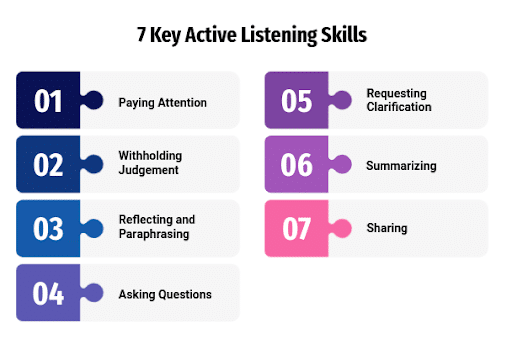
-
Paying attention
This is an obvious one. Good listening requires paying attention. That means if you’re in a video meeting, don’t flick between browser tabs when someone’s talking to you. Don’t look at your social media apps in meetings. Pay attention to what’s being said, and you’ll be able to listen actively.
-
Withholding judgement
Communication at work isn’t always easy. Sometimes employees have conflicting perspectives, or clients are unreasonable. An active listener, however, withholds judgement when listening and keeps an open mind.
This means avoiding thinking patterns that put your judgement over the perspective of the person you’re listening to. It also means you’re practising empathic listening—showing empathy and acceptance rather than judgement and disagreement in your responses.
-
Reflecting and paraphrasing
Active listening also involves how you respond when listening. Reflecting and paraphrasing is the practice of repeating back what someone is telling you in your own words.
There are two benefits to doing this. First, it shows that you’re listening as you’re able to paraphrase someone’s sentiments accurately in your own words. Second, it helps you process what you’re being told.
-
Asking questions (both open-ended and probing)
Asking questions is another important part of active listening that ensures the conversation is productive for you and the person you’re listening to.
When asking questions, you should focus on making open-ended and probing queries. Open-ended questions allow the other person to elaborate, rather than a closed-ended, usually a “yes” or “no” response. Probing questions encourage the other person to explain their opinions and ideas in more detail.
-
Requesting clarification
Even if everything someone is saying to you is crystal clear, requesting clarification ensures that you understand them while showing them that you’re actively listening.
This can be as simple as repeating what’s been said to you in a simpler way to clarify what the other person has said. It can also involve asking the speaker to give examples or to expand upon certain points.
-
Summarising
Summarising is similar to reflecting, paraphrasing, and requesting clarification, as it involves repeating what has been concisely said to you.
When you summarise, you should take the main points of what the speaker has told you and reiterate them clearly. This allows the speaker to correct you whilst also reminding both you and the speaker what the central points of the conversation have been. This will help with decision-making post-discussion.
-
Sharing
Sharing is the part of the conversation where you introduce your own thoughts and ideas. This should only be done when you have gained a clear understanding of what the speaker is trying to tell you.
Sharing your own ideas or similar experiences with the speaker shows empathy and strengthens the connection between you. There is, however, a fine line between sharing and taking over the conversation—effective listening requires a balance between listening and sharing.
What are the signs of active listening?
We all know a good listener, but it might be difficult to pin down why we find talking to them so productive and positive. The signs of active listening can be split into two categories: Non-verbal cues and verbal cues.
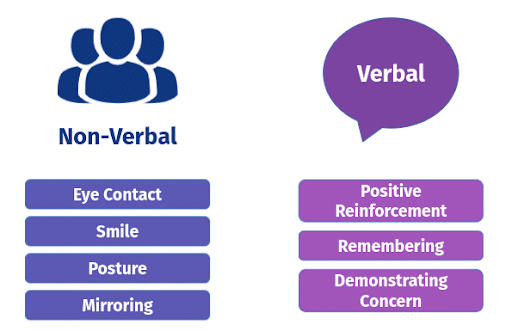
Non-verbal
Active listeners employ various non-verbal cues to show speakers that they’re interested in and engaged with what they’re being told.
-
Eye contact
If your eyes are flitting elsewhere, anyone trying to talk to you will be unsure of whether or not you’re really listening. Eye contact is an important way to show someone you are paying attention.
-
Smile
Smiling when you’re listening to someone else reassures them that you’re interested in and agree with what they’re saying.
Of course, there are times when smiling isn’t appropriate. Other facial expressions and actions such as raised eyebrows or nodding your head are great non-verbal cues to use when listening.
-
Posture
Body language plays an important role in active listening, but you may be surprised that posture is another non-verbal cue that speakers pick up on when you’re listening to them.
Facing the speaker, leaning in slightly, and avoiding slouching or folding your arms shows the speaker you’re paying attention, you’re interested in what they have to say, and you’re taking the conversation seriously.
-
Mirroring
Mirroring is a simple active listening technique that can help whoever is speaking to you feel more at ease and understood. It’s the practice of copying the facial expressions, gestures, and posture of the person speaking to you.
Mirroring is also a helpful exercise as a listener, as it lets you pick up on the speaker’s non-verbal cues as you listen.

Verbal
Whilst active listening means putting the voice of the speaker. First, this doesn’t mean you should sit in silence for the entire conversation. You can use some important verbal cues to show you are listening and understand the speaker better.
-
Positive reinforcement
Using positive reinforcement as an active listening technique involves using words of agreement to encourage the speaker to continue and show that you’re engaged.
It’s important not to use this too much, as you could end up distracting the speaker rather than encouraging them.
-
Remembering
Remembering what you have been told by a speaker is a key part of active listening. This can be shown verbally by repeating and summarizing what’s been said and circling back to earlier key points when need be.
-
Demonstrating concern
The demonstrating concern is when active listening slides into empathic listening. The concern is shown through your tone of voice, giving the speaker your full attention, and keeping an open mind.
If someone comes to you with a problem, demonstrating that their concerns are valid and valued is an important skill.
How to become a better active listener
Now that you know what active listening is, what it looks like, and why it’s important, you’re ready to put practices into action to improve your listening and communication skills.
Here are five simple yet effective ways you can become a more effective listener and communicator.
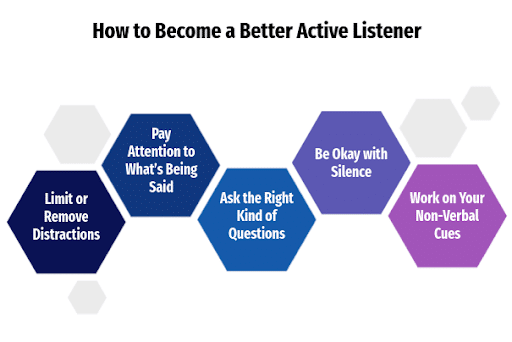
-
Limit or remove distractions
Whether you’re listening to someone in person, over the phone, or on a video call, you must limit distractions.
If you have your emails and LinkedIn open, for example, a notification could distract you, break the flow of the conversation, and prevent you and the speaker from entering into a productive discussion.
-
Pay attention to what’s being said instead of what you want to say
Sometimes we think the best thing we can do if someone comes to us is offer excellent advice. A lot of the time, however, people want to be listened to rather than advised.
Rather than spending conversations thinking about how you’ll respond, focus on what the other person is saying. This will help you pay attention and, ultimately, give you the unique information you need to respond effectively.
-
Ask the right kind of questions.
Open-ended questions instead of closed-ended questions are an important part of effective communication. This is because open-ended questions allow the speaker to elaborate and provide more detail, making the conversation more productive for both of you.
-
Learn to be okay with silence
Many of us try to fill the silence with conversation. It’s a natural thing to do, but it won’t help you become a better listener.
Silence gives you and the speaker time to reflect on what’s been said and pause over the key points. Rather than trying to fill silences with your own point of view, use it as breathing room for everyone involved in the conversation.
-
Work on your non-verbal communication
Eye contact, facial expressions, and body language all play an important role in active listening. If using non-verbal cues in conversations doesn’t come naturally to you, you should find ways to improve on it.
Next time you’re speaking to someone you consider a good listener, pay attention to their non-verbal cues and mirror them.

Final thoughts
Effective listening can transform your interpersonal skills at work. Colleagues, customers, and clients all want to be reassured that their voices matter, and active listening helps you do that.
With so many employees working from home, remote communication can make active listening feel more difficult than when you could talk face-to-face.
While non-verbal cues like body language won’t be as effective, limiting distractions and using verbal cues such as positive reinforcement, mirroring, and summarising still work. What’s more, they will show listeners that even if you are separated by a computer screen, their voice is as important to you as ever.
Originally published Aug 18, 2021, updated Mar 12, 2024
